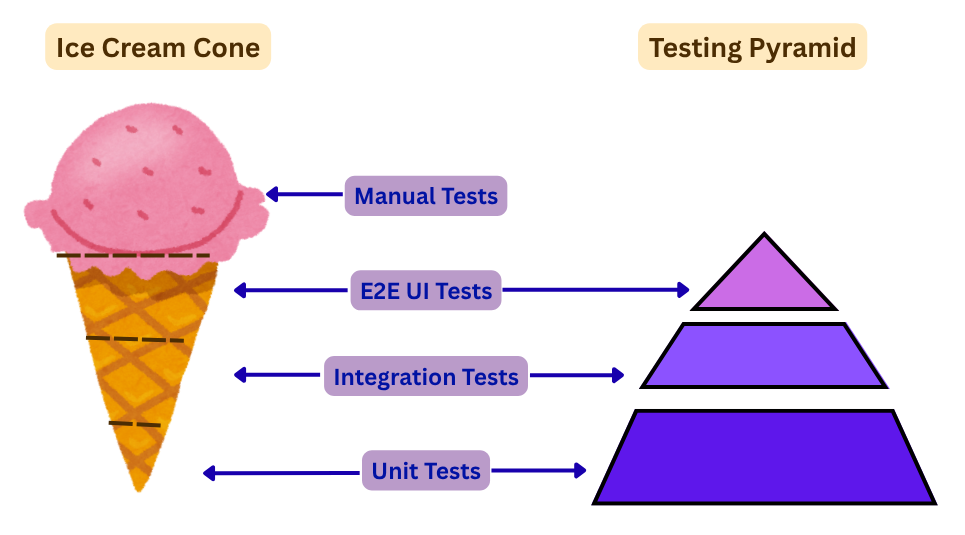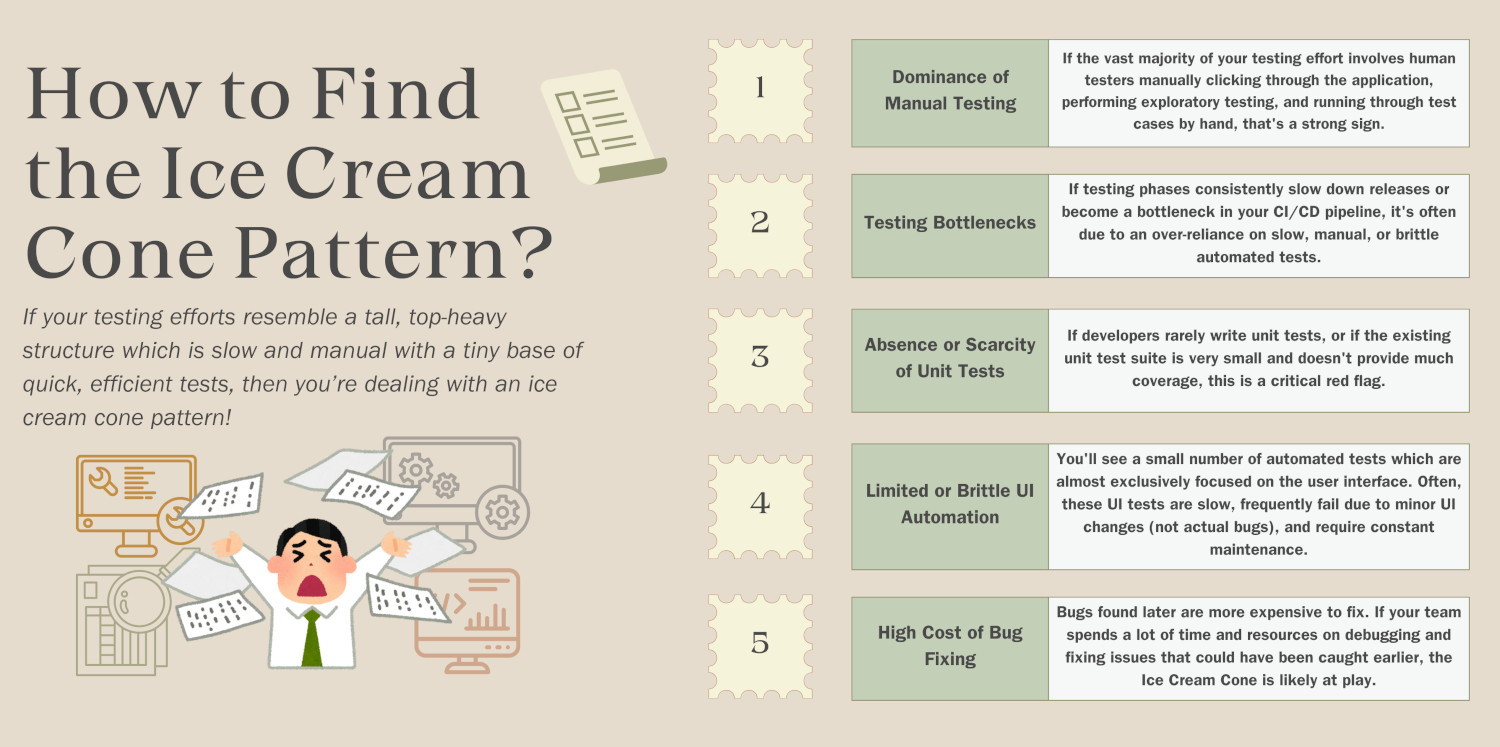The Ice Cream Cone Testing Approach: Benefits & Pitfalls
|
|
Software testing is paramount, and test automation is the way ahead. This is something everyone in the IT industry understands and acknowledges. Yet, you will see instances where organizations have hundreds of automated tests, and still complain about the ineffectiveness of automated testing.
If you look beneath the surface, you’ll probably find that what’s being automated isn’t strategic; it’s an attempt to automate the previously used manual test cases. This brings us to one classic anti-pattern, the Ice Cream Cone. It is often viewed as the inverse of the Testing Pyramid.
These approaches aren’t mere diagrams mimicking real-world objects. Their main purpose is to provide guidance when trying to automate software testing. While an Ice Cream Cone Pattern is generally considered a problem, it does benefit in certain situations.
Let’s define the model, explain its significant pitfalls, and contrast it with the industry-standard Testing Pyramid.
| Key Takeaways: |
|---|
|

What is the Ice Cream Cone Testing Approach?
This testing approach is exactly what its namesake sounds like – an ice cream cone. More than being a testing approach, it is an anti-pattern that crops up and can be viewed as the inverse of the Testing Pyramid.
In any testing approach, we consider automating at different levels of the application (unit level – the most granular level, integration level – a mix of units, end-to-end or UI level – considering the user’s perspective).
Let’s go through the parts of the ice cream cone approach from top to bottom.
- Top Scoop – Manual and Exploratory Testing: The ice cream scoop at the top, a large portion, comprises of manual testing. Before building any other type of automation, the focus is on manual testing.
- Top of the Cone – E2E Testing: From here on, we are looking at an inverted triangle. Thus, the top layer, the largest of the triangle, is taken up by E2E UI testing. Focus remains on automating the tests that can cover E2E scenarios.
- Mid Tier of the Cone – Integration Testing: Some portion, lesser than the above ones, is allotted to integration tests.
- Bottom of the Cone – Unit Testing: Finally, the smallest portion is reserved for unit testing. In some cases, you might see unit testing being completely left out.

Benefits of the Ice Cream Cone Approach
So, why do teams often find themselves building an “Ice Cream Cone” instead of a more balanced strategy? It usually stems from a few common scenarios: perhaps there’s a strong historical focus on manual QA, a development culture where unit testing isn’t deeply embedded, or simply immense pressure to ship features quickly, leading to shortcuts in foundational testing.
Sometimes, in very specific contexts, the ice cream cone approach can seem like the most straightforward path, or it might even offer some immediate, albeit limited, advantages.
- Initial Simplicity and Speed (for very small projects): For tiny, non-critical applications, legacy systems without good unit or integration tests, or perhaps for building a proof-of-concept, minimum viable product, or prototyping, the Ice Cream Cone can feel like a quick way to get started. If you have limited resources and a very short timeline, relying heavily on manual checks might seem faster than setting up a comprehensive automated test suite from scratch. You can get immediate feedback from a human perspective without the upfront investment in automation infrastructure.
- Direct User Experience Validation: UI tests, whether manual or automated, are the most direct way to validate the actual end-user experience. This “what the user sees” validation is undeniably valuable, even if it’s the most expensive and slowest type of test.
- Empowering Non-Technical Testers: Many QA teams have a strong background in manual and exploratory testing. The Ice Cream Cone approach, with its heavy emphasis on human interaction, allows these skilled testers to contribute immediately and effectively through manual and exploratory testing. It doesn’t require them to learn complex coding languages or automation frameworks, enabling them to jump right in and start finding bugs based on their deep understanding of user behavior and application functionality.
While these points might explain its initial appeal, it’s crucial to remember that these “benefits” are often short-lived and quickly overshadowed by the scalability, maintenance, and feedback loop issues we discussed earlier. They represent a trade-off that typically doesn’t pay off in the long run for most serious software projects.
The Pitfalls of the Ice Cream Cone Approach
While the Ice Cream Cone might seem like a straightforward way to start testing, it’s actually a software testing anti-pattern for a reason. This approach, despite its initial appeal, introduces a host of problems that can seriously hinder your development process and ultimately impact your product’s quality and your team’s efficiency.
Let’s break down the major pitfalls:
- A Painfully Slow Feedback Loop: When you rely heavily on manual testing and E2E UI automation, finding bugs becomes a slow, drawn-out process. Imagine a bug introduced early in development that only gets caught when a human tester manually clicks through a complex flow days or even weeks later. The longer a bug lives in the code, the more expensive and difficult it becomes to fix. This slow feedback means developers aren’t getting immediate insights, leading to more rework and a sluggish development cycle.
- High Cost and Resource Intensive: Manual testing, by its very nature, demands significant time and human effort. As your application grows, so does the need for more manual testers, or existing testers become overwhelmed. On top of that, maintaining those limited UI automation tests is often a hidden cost. They tend to be brittle, meaning they break easily with minor UI changes, requiring constant updates and consuming valuable developer or QA time that could be spent elsewhere.
- Brittle and Unreliable Automation: UI-level tests are notoriously fragile. A simple change to a button’s ID, a slight layout adjustment, or even a new animation can cause an automated UI test to fail, even if the underlying functionality is perfectly fine. This leads to a high number of false positives and a general lack of trust in the automated test suite.
- Difficulty Pinpointing the Root Cause: When an E2E UI test fails, it tells you that something is wrong, but it rarely tells you where the problem lies. Did the database query fail? Was it an issue with the API integration? Or just a small UI rendering glitch? Debugging becomes a detective mission, requiring significant time to trace the failure back to its source. This contrasts sharply with unit tests, which fail precisely where the problem code resides.
- A Serious Lack of Scalability: As your application expands, the Ice Cream Cone approach simply doesn’t scale. The sheer volume of manual testing becomes unmanageable, leading to longer release cycles and a higher risk of defects slipping through. The brittle UI automation suite becomes a bottleneck, constantly needing fixes and updates, rather than providing reliable, fast feedback.
Ice Cream Cone and Testing Pyramid
So, if the Ice Cream Cone is an anti-pattern, what’s a better way to approach software testing? The answer lies in what the industry considers the gold standard: the Testing Pyramid. This model offers a far more robust, efficient, and scalable strategy for ensuring software quality.
Unlike the top-heavy Ice Cream Cone, the Testing Pyramid is built with a wide, strong base that narrows as it goes up. This inverted structure represents the ideal distribution of your testing efforts:
- The Broad Base – Extensive Unit Tests: At the very bottom, forming the foundation of your testing strategy, are unit tests. These are small, isolated tests that check individual pieces of code – think functions, methods, or classes – in isolation. They are incredibly fast to run, reliable, and cheap to maintain.
- The Middle Layer – Solid Integration and API Tests: Moving up the pyramid, you find integration tests and API tests. These tests verify that different components or services of your application work correctly together. They’re faster and more stable than UI tests, providing good coverage of your system’s interactions.
- The Narrow Top – Minimal End-to-End UI Tests: At the very peak of the pyramid are your E2E UI tests. While crucial for validating the complete user experience, these are the slowest, most expensive, and most brittle tests. In the Testing Pyramid model, you keep these to a minimum, reserving them only for the most critical user journeys. Since lower-level tests have already verified individual components and integrations, your UI tests simply confirm that everything ties together correctly from a user’s perspective, without needing to re-test every single piece of functionality.
The key advantages of embracing the Testing Pyramid are clear:
- You get faster feedback throughout the development cycle, leading to quicker bug fixes and more agile teams.
- It results in lower overall costs because you’re catching issues early and relying less on expensive manual and brittle UI automation.
- Your test suite becomes more reliable and trustworthy.
- This approach is highly scalable, allowing your testing efforts to grow efficiently with your application.
Conclusion – Flatten the Cone, Build the Pyramid!
The message is clear: the Ice Cream Cone testing approach, while seemingly simple at first glance, is a deceptive anti-pattern. Its heavy reliance on slow, expensive manual testing and brittle UI automation creates a recipe for delayed feedback, spiraling costs, and a testing process that simply can’t keep up with the demands of modern software development. If your current testing strategy feels like you’re constantly battling melting ice cream – slow, messy, and hard to manage – it’s time to re-evaluate.
| Achieve More Than 90% Test Automation | |
| Step by Step Walkthroughs and Help | |
| 14 Day Free Trial, Cancel Anytime |












